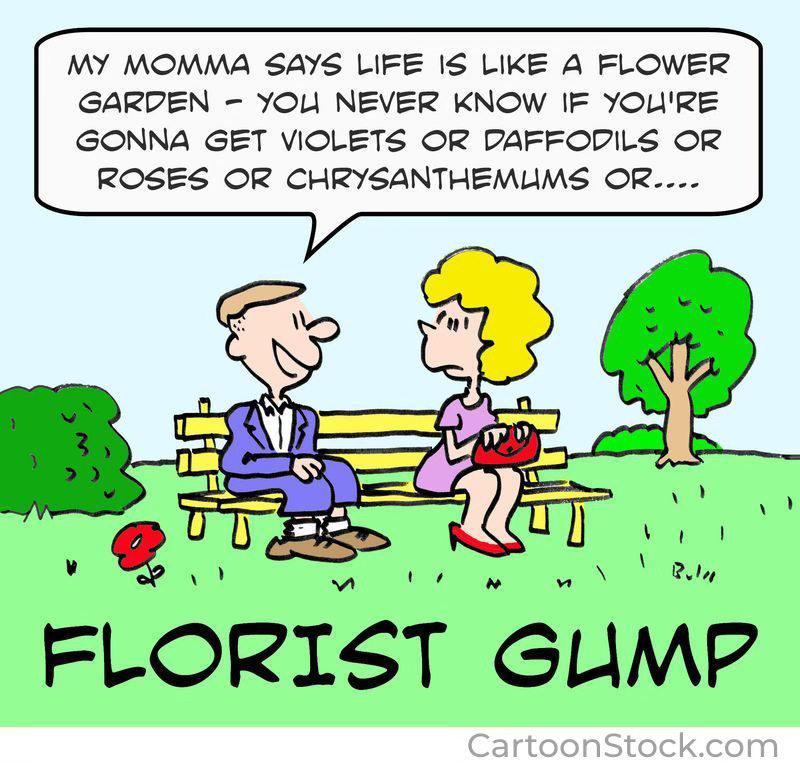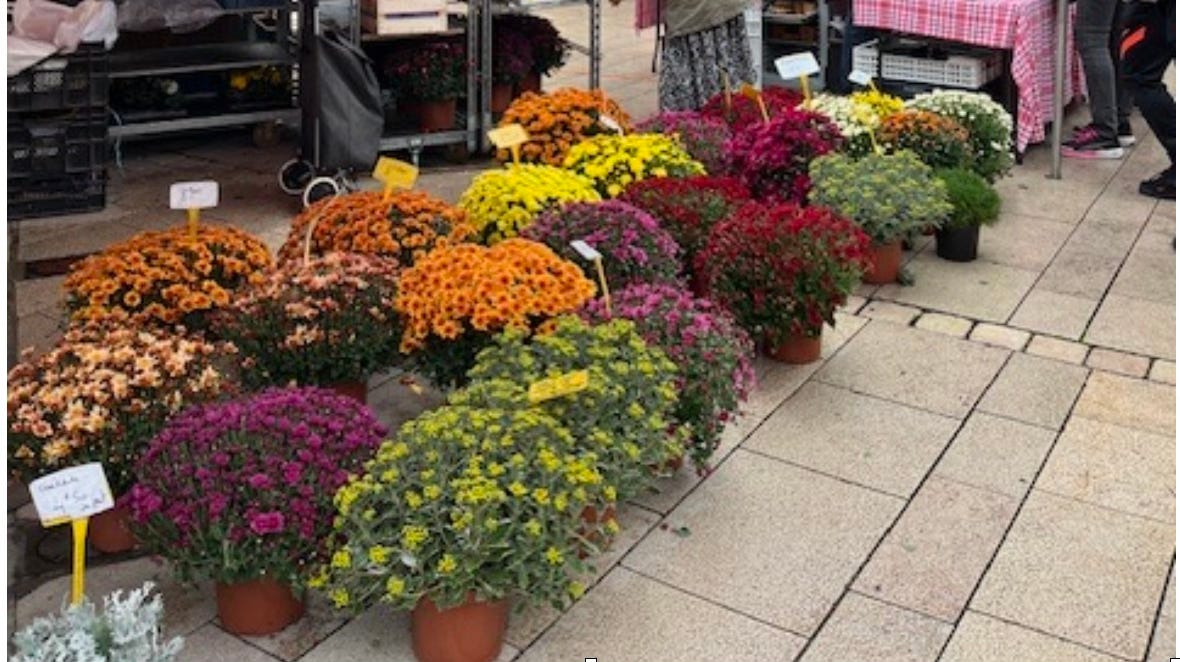In mid-October, I always bought two chrysanthemum plants to brighten my front doorstep in Montecito, California, where I lived with my husband for fifteen years. The outdoor plant stand at Trader Joe’s, overflowing with a panoply of colored mums, reminded me how much I loved seeing this French flair flourish in Burgundy, when we would visit our family in Burgundy in October and November. It also reminded me how for those many visits I shared recipes with my daughter, a wine executive and fabulous cook, with chrysanthemum flowers and leaves from her local organic épicerie.
In Burgundy, as in the rest of France, mums are on display from Toussaint (All Saints’ Day) on November 1, and for Armistice Day, to mark the end of World War One. On the 11th day of the 11th month at the 11th hour in 1919, George Clemenceau called upon the French to decorate the tombs of fallen soldiers. The mum was chosen as the preferred blossom because it was one of the few plants flowering at that time of the year.
Toussaint is not a biblical holiday but a Catholic solemnity honoring the saints, known and unknown. French cemeteries in November burst with colored mums as the nation mourns its patriotic deceased family members and heroes. If one is lucky to be in France in October and November your eye is constantly enchanted by how the French decorate store windows, window boxes and dining tables with mums and savoir faire. The French buy more than 23 million of the plants from 9,000 French cultivators.
Apart from their role in national fêtes, colored mums are offered as symbols: yellow for perfection, red for intense love, white for pure love, pink for infatuation that might turn into real love. It is said that in France that if one dreams of mums, one is waiting for love and marriage.
The first symbolic use of mums may date back to around 1,500 BC in China, where the flower symbolized nobility and hardiness and was given to families who had a newborn. It’s boiled roots make a calming tea or a treatment for headaches. Its petals are added to salads. As a ritual, nectar from the petals is served on the ninth day of the ninth moon during an autumn festival known as the Double Nine.
Japanese Mums
Only the Japanese outdo the French and Chinese in their adherence to and affection for the mum. In Japan, mums have been cultivated since the 8th century, when they were chosen as the imperial symbol, representing the sun. The blossom adorns the country’s flag and all pertaining to the empire. The emperor sits on the Chrysanthemum Throne. During World War II, kamikaze pilots used the mum as their symbol. The Order of the Chrysanthemum is the highest award for bravery. Ikebana, the Japanese art of flower arranging, often uses mums because of their variety of color and shape. In November, in the Tokyo suburb of Bunkyô, the annual Chrysanthemum Festival exhibits from over 2,000 varieties. Japan claims to have developed 350 of the approximately 20,000 known varieties.
For Americans, mums simply signal the beginning of fall and harvest. It did for me, until I moved to France three years ago, following the death of my beloved husband, Richard, of 50 years. Now, I rush to the market as soon as mums appear, to fill my window boxes with this seemingly boring and inexpensive flower that will last through Christmas, and filling vases at Thanksgiving to focus the eye on fall’s subtle, yet luscious striking colors. In fact, mums are anything but boring. And they are edible, as I’ve learned from spending so much time in France.
Beaune, 15 minutes from my 300 year-old vintner’s cottage in Meursault, begins its assault on my senses in mid-October. It’s a town of immense medieval charm, tiled Burgundian roofs reflecting the myriad colors one finds in mums. It was there on a Saturday morning market visit that I discovered a marchand’s basket overflowing with crenelated mum leaves that would make a tangy pesto.
During our annual visit, my daughter and I made dainty chrysanthemum madeleines from ground mum blossom. My granddaughter helped us dip them in melted pink chocolate. We were starting a new tradition--- perhaps as an homage to Marcel Proust‘s “Remembrance of Things Past.” Les petits gâteaux (the French consider madeleines cakes, not cookies) with a soupçon of chocolate ganache elevates the fabled délice to a visual and gustatory level which would have the fabled French author’s lips sing.
Chrysanthemum Leaf Pesto
Ingredients:
One bunch of chrysanthemum leaves (3.5 oz), 1/4 cup roasted pine nuts, 1 large, minced garlic clove, 1/4 cup grated parmesan cheese, 1/3 to 1/4 cup olive, salt, and ground pepper
Directions
Bake pine nuts in a 350 degree oven until lightly golden (20 minutes)
Wash chrysanthemum leaves. Blanch them in boiling water and then dip them in cold water to stop cooking further. Drain well, squeeze to remove extra water, then chop finely.
Place pine nuts, leaves, garlic, cheese, salt and pepper in food processor, gradually adding oil until smooth and well combined.
Madeleines
Ingredients:
Dry: 1 cup plus 1 tbsp whole wheat flour, 4 tbsp ground chrysanthemum powder, 1 tsp baking powder.
Wet: 1/2 cup almond milk, 1/3 cup agave syrup, 1 tbsp lemon zest, 2.5 oz. Vegetable oil, 1 tsp lemon juice, 1 tsp vanilla bean paste
Chocolate Ganache: 1 oz. dark chocolate, 2 oz. Ruby chocolate, chopped pistachios.
Directions:
Preheat oven to 350 degrees F. Grease madeleine molds with butter. In a large bowl, sift flour and baking powder. In another bowl, add milk and syrup and whisk until well combined. Add oil, zest, lemon juice, ground chrysanthemum powder and vanilla. Whisk to combine.
Pour wet ingredients over dry and whisk until just combined. Using an ice cream scooper or spoon, scoop the batter into buttered madeleine forms. Bake for 10-15 minutes, until a took pic comes out clean.
Allow madeleines to cool in molds for 5 minutes. Then flip them on the other side to cool completely.
The Grenache: gently melt the chocolates over warm water. Stir to combine. Let cool to room temperature.
Dip the madeleines into the chocolate and chopped pistachios and place on a grid to drain excess.
Bon Appetit!
Community Calendar:
Got a Santa Barbara event for our community calendar? Fenkner@sbcurrent.com







France would be a great country if you could somehow change their genetics to make them less entitled, arrogant, supercilious and obnoxious. Also, instill a work ethic which is currently lacking.
Thank you for expanding my own ready pesto sauce possibilities. I left the formality of the "official" pesto recipe list some time ago myself to use arugula and parsley. Always a delight to be taken on your market romps around your beloved new home country.
So now I shall also try chrysanthemum leaves as well. In addition, my other pesto recipe deviations using walnuts and 1000 day aged Gouda from Trader Joe, for the pine nuts and Parmesan. Poor man's pesto for me.
When living in Italy, we were warned never to bring chrysanthemums as a hostess gift, since they symbolized mourning and death. I now see why that association was made. Yet nothing stopped them from spilling out of flower boxes for loads of autumn cheer.
Again, thank you for your always engaging respites from our own local political intensities. As we rapidly approach King Newsom's imperial takeover of our previously "independent" voting district allocations. From Jerry Brown to Newsom's gerrymandering is not progress. It is very scary regression.